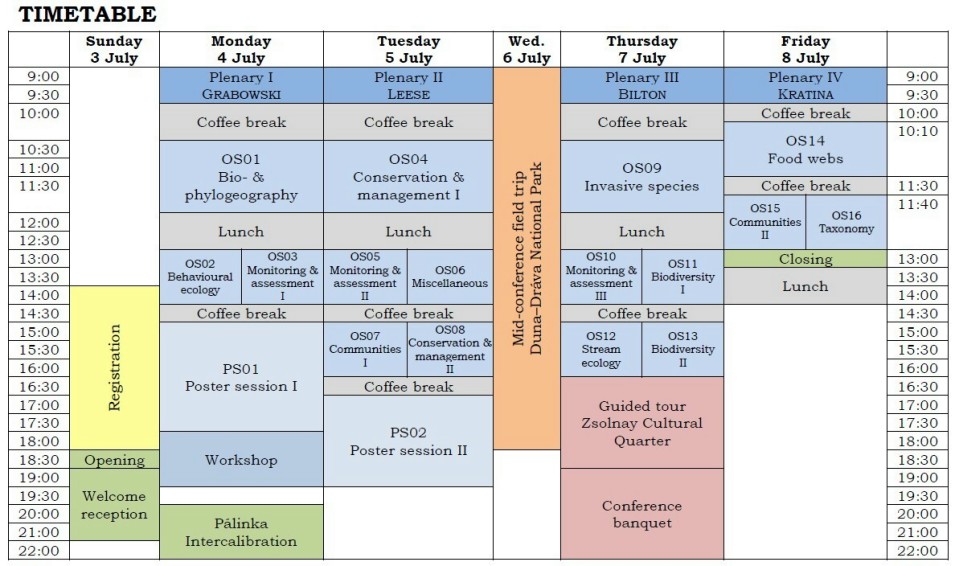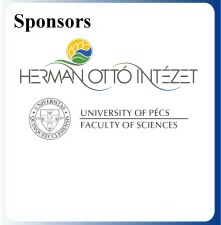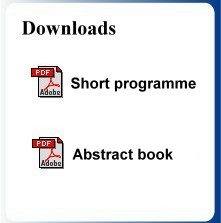|
|
|
 |
| |
|
The detailed
scientific programme is available here as a pdf file:
 |
|
|
|
|
|
PLENARY LECTURES |
| |
|
Michal GRABOWSKI
(University of Lodz, Poland)
European
freshwater biota -
from rise of the
continent to human impact
Monday, 4 July,
9h
In general view,
Europe is recognised as less interesting field for biodiversity
studies than the tropical regions of the world. Such opinion is
biased mostly by comparably low number of formally described species
especially in such flagship taxa as vertebrates, insects or molluscs
and by the believable calamitous role of Pleistocene glaciations in
shaping European biodiversity.
Such view has
begun to change with, published nearly twenty years ago, works upon
“genetic legacy of Quaternary ice ages” by the late Godfrey Hewitt
and his team. This already classical set of publications presented
an intricate pattern of distribution of numerous phylogenetic
lineages within formally recognised species, surviving and
diversifying during ice ages in several southern glacial refugia and
then recolonising more northern regions of Europe. Numerous further
studies have brought even more intriguing information, particularly
in case of freshwater biota. Unexpected presence of glacial refugia
was discovered in northern regions of Europe. In case of several
groups, such as crustaceans, extraordinarily high level of cryptic
diversity and deep divergence within morphospecies were revealed.
This showed that their evolutionary history in Europe reaches far
beyond Pleistocene and dates back to the very beginning of Europe as
a continent that we know now. The knowledge questioned the widely
accepted Banarescu’s view on biogeography of freshwaters in Europe.
Looking at the new level of diversity has also greatly enhanced
taxonomic studies and affected the rationale behind nature
conservation.
Such
accumulation of information upon the real extent of diversity and
origins of European freshwater biota has overlapped in time with
ongoing colonisation of local inland waters by various nonindigenous
invasive species. Their routes and pathways of dispersal as well as
consequences for local ecosystems are another fascinating research
program. During my talk I will provide the audience with outline of
the dynamic changes of European paleogeography and associated
climate changes, showing how they affected the present day diversity
and distribution of main freshwater taxonomic groups. I will also
cover the most recent changes in biodiversity patterns in inland
waters due to spread of invasive species. The talk will be
illustrated with a wide selection of case studies coming both from
my team’s published and unpublished works as well as from other
sources.
|
 |
|
|
|
|
Florian
LEESE
(University of Duisburg-Essen, Germany)
From genes to
ecosystems:
Assessing stressor effects
on freshwater macroinvertebrates with genomic approaches
Tuesday,
5 July, 9h
As a consequence
of anthropogenic action, freshwater ecosystems have been drastically
degraded over the past centuries with severe consequences for
biodiversity and ecosystem function. To counteract degradation, many
restoration efforts from small and local to large international
catchment-spanning activities have been launched. Here,
macroinvertebrates are central indicators to quantify the loss of
biodiversity in response to anthropogenic stressors and its
subsequent recovery. Unfortunately, determination of
macroinvertebrates with morphological methods, specifically of their
juvenile stages, is difficult and frequently leads to incorrect
results. In addition, the level of genetic variation is not included
in the contemporary approaches. Therefore, current assessments are
limited in their power to gain deeper process understanding. In my
talk I will outline how genetic and genomic tools can be routinely
applied to study responses of macroinvertebrates to stressors. Using
case studies from Europe and New Zealand, I will outline how the
impact of stressors on populations can be studied using genetic and
genome-wide polymorphism data. The data show that critically
important responses of biodiversity are overlooked when only relying
on morphological data. Second, I will show how DNA-metabarcoding can
be routinely integrated into present-day biodiversity assessment to
improve biodiversity – ecosystem function responses to environmental
stressors. |

|
|
|
|
|
David BILTON
(Plymouth
University, UK)
Comparative ecophysiology, rarity and vulnerability
to global change in aquatic insects
Thursday, 7
July, 9h
Most species are
rare, with relatively small geographical ranges, comparatively few
organisms being naturally widespread. This pattern is commonly
observed within individual clades, including many freshwater taxa.
Individual genera are often dominated by narrow range endemics, but
frequently include a handful of widespread species, which are
ecologically and morphologically similar to their more restricted
relatives. A variety of ecological and evolutionary processes may
underlie such range size variation, one of the most popular
hypotheses suggesting that widespread species have broader
fundamental niches than narrow range taxa. Despite this common
assumption, there have been very few empirical tests of such ideas.
Variation in physiology can play a pivotal role in determining
differences in niche breadth, predicting that widespread taxa will
have broader ranges of physiological tolerance than restricted-range
relatives, providing a potential means of testing niche theories of
rarity.
My talk will
summarize work over the last decade which has explored these ideas,
mainly in water beetles, by studying closely related species which
often differ dramatically in the extent of their geographical
distributions. I argue that within a given habitat type
physiological tolerance appears to be strongly associated with both
range size and position, but that shifts between habitats may drive
dramatic changes in distribution. I will go on to consider how such
comparative studies may lead to a better understanding of organismal
responses to global change, through both direct and indirect effects
in nature.
|
 |
|
|
|
|
Pavel KRATINA
(Queen Mary
University of London, UK)
Indirect
impacts of climate warming
in pelagic
and benthic food webs
Friday,
8 July, 9h
Rising
temperatures, declining predator populations and eutrophication are
three pervasive pressures affecting aquatic ecosystems. These
processes may interact in a number of ways that are likely to vary
seasonally, as temperature affects consumer-resource interactions
and metabolic processes. We used a year-long experiment with 1200 L
mesocosms to investigate the combined effects of warming, nutrient
load and fish predation on freshwater communities. We observed
strong top-down and bottom-up effects on plankton communities, and
these effects varied over time. Enhancement of phytoplankton biomass
with added nutrients is strongest when fish are present, primarily
due to fish predation on large cladocerans. Warming enhances trophic
cascades (particularly during winter) and reduces effects of
eutrophication (particularly in summer). Although fish had
significant cascading effects in both benthic and pelagic
environments, the interactive effects of fish and temperature were
substantially weaker along benthic and detrital pathways. This
suggests that more reticulate benthic compartments may be more
resistant to climate warming than simple pelagic food chains. We
also show that fish predation suppresses the emergence of aquatic
organisms into terrestrial ecosystems and reduces decomposition of
terrestrial detritus in aquatic ecosystems. On the other hand,
warming and nutrients both enhance cross-ecosystem fluxes,
especially in systems without fish. Warming also increased net
ecosystem production, while reducing the standing biomass of the
dominant primary producers, indicating that warming speeds up energy
movement throughout food webs. Our results show that the effects of
simultaneous perturbations are often synergistic rather than
independent. This indicates that the impacts of undergoing global
warming will depend on local nutrient status or predator abundance. |
 |
|
|
|
| |
|
|
| |
|
 

 

   |